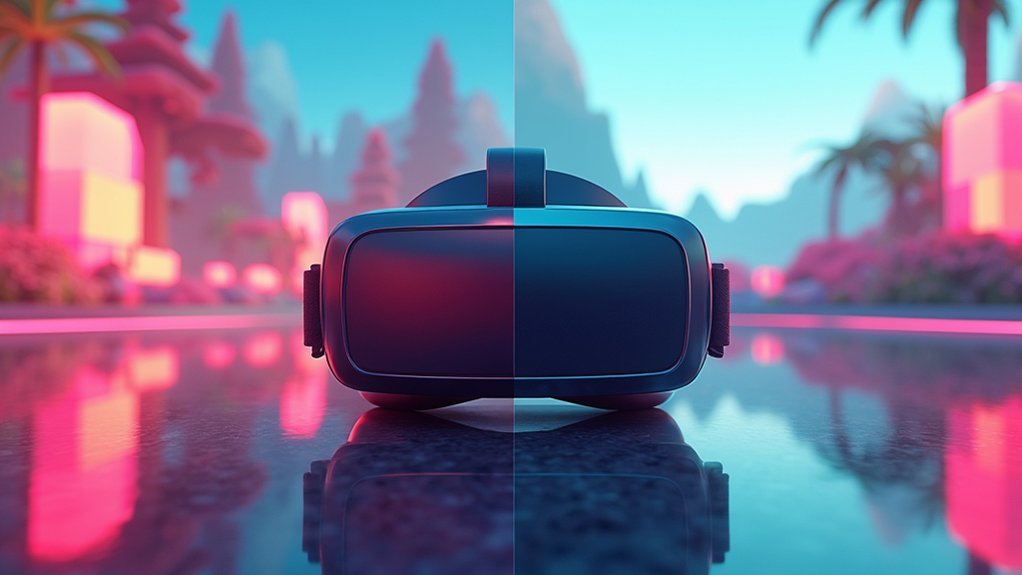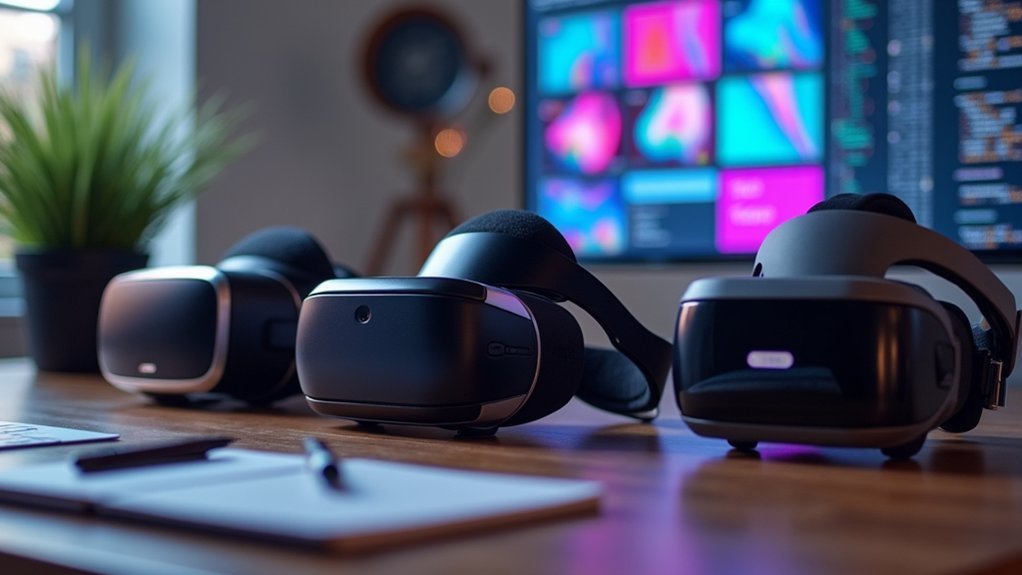You’ll want to prioritize Unity for rapid development cycles and extensive platform support, while Unreal Engine 5 excels in high-fidelity graphics with real-time ray tracing. Consider your team’s expertise—Unity requires C# skills, Unreal demands C++ proficiency. Both engines offer robust VR SDK support for Oculus and HTC Vive, though you’ll need to evaluate framework maturity, security compliance, and cross-platform compatibility. Performance optimization techniques and cost-benefit analysis will guide your final decision toward the most strategic choice.
Unity Vs Unreal Engine: Performance Benchmarks for VR Applications

When you’re developing VR applications, the choice between Unity and Unreal Engine becomes critical for achieving ideal performance benchmarks.
Unreal Engine 5 consistently outperforms Unity when rendering complex scenes, delivering superior graphical output through real-time ray tracing capabilities that enhance visual fidelity. You’ll find Unreal excels at creating cinematic-quality visuals and intricate environments for immersive VR experiences.
Unreal Engine 5’s real-time ray tracing delivers cinematic-quality visuals that consistently outperform Unity in complex VR scene rendering.
However, Unity’s strength lies in cross-platform development versatility, supporting over 25 platforms with faster iteration times.
You’ll benefit from Unity’s extensive asset store and streamlined workflow for prototyping. While Unreal dominates in advanced rendering techniques, Unity offers better community resources and asset integration.
Your choice should align with project requirements: prioritize Unreal for high-fidelity graphics or Unity for rapid development cycles.
Evaluating Development Team Expertise Requirements Across VR Platforms
When choosing a VR engine, you’ll need to assess your team’s programming expertise since Unity requires C# proficiency while Unreal Engine demands C++ skills.
You must also evaluate how quickly your developers can master platform-specific APIs like Oculus SDK or SteamVR, as this directly impacts project timelines.
Consider your team’s current skill gaps and learning capacity, since each VR platform presents unique technical challenges that’ll require different knowledge bases to overcome.
VR Programming Language Skills
Look for developers familiar with VR-specific SDKs like Oculus SDK, SteamVR, and OpenXR to guarantee proper hardware integration.
Cross-platform game development requires knowledge of these APIs for compatibility across different headsets.
Additionally, your team needs experience with VR-tailored UX/UI design principles, since virtual environment interactions differ drastically from traditional applications.
JavaScript knowledge may also prove valuable depending on your chosen platform and implementation requirements.
Platform-Specific Technical Knowledge
Since each VR platform operates with distinct technical architectures, you’ll need developers who possess deep expertise in the specific platforms you’re targeting.
When evaluating cross-platform app development framework options, your team must understand how each game engine handles platform requirements differently.
Essential platform-specific knowledge areas include:
- SDK Mastery – Proficiency in platform-specific SDKs like Oculus SDK or SteamVR, alongside programming languages commonly used such as C# for Unity or C++ for Unreal Engine.
- Hardware Optimization – Deep understanding of VR hardware capabilities and limitations across devices like Quest, Vive, or PICO to optimize performance effectively.
- Interface Adaptation – Specialized user interface design skills for VR environments, as traditional UI concepts don’t translate to immersive experiences.
Team Learning Curve
You should assess the programming language called Dart if considering Flutter for VR projects.
JavaScript developers often shift smoothly to web-based VR frameworks.
Community support greatly impacts your development process – Unity’s extensive documentation and active forums reduce onboarding time considerably.
Evaluate your team’s existing skills against each engine’s requirements to minimize training costs and accelerate project timelines.
Native VR Feature Access: Comparing SDK Limitations and Capabilities
When developing VR applications, you’ll find that native feature access becomes the defining factor between engines that deliver truly immersive experiences and those that fall short.
Cross-platform development engines vary dramatically in their VR capabilities, making your choice vital for project success.
Here’s how major engines compare for native VR feature access:
- Unity and Unreal Engine lead with robust SDK support for Oculus and HTC Vive, offering dedicated tools and optimization features that guarantee seamless VR performance across multiple headsets.
- Godot provides flexibility but requires additional community plugins and setup to match Unity’s native capabilities.
- React Native and Flutter offer limited or developing VR support, making them unsuitable for complex immersive applications requiring full native feature integration.
Cross-Platform VR Deployment Strategies for Multiple Headset Support

When you’re deploying VR applications across multiple headsets, you’ll face three critical challenges that determine your project’s success.
First, you must guarantee hardware compatibility between devices with vastly different tracking systems, controllers, and display specifications.
Next, you’ll need to optimize performance for varying hardware capabilities while integrating platform-specific features that make each headset unique.
VR Hardware Compatibility
Because VR hardware varies considerably in tracking systems, input methods, and performance capabilities, you’ll need development engines that can seamlessly adapt your applications across multiple headset ecosystems.
Unity and Unreal Engine excel at cross-platform development by supporting standardized APIs like OpenXR, which guarantees your VR applications work consistently across Oculus, HTC Vive, and Valve Index devices.
Implementing modular design principles allows you to customize content for each platform’s unique specifications while maintaining core functionality.
Here’s how to maximize VR hardware compatibility:
- Choose engines with robust community support that provide regular updates for emerging VR technologies
- Utilize standardized APIs like OpenXR to minimize platform-specific coding requirements
- Test extensively across target devices to optimize performance and identify hardware-specific issues early
Performance Optimization Techniques
Achieving ideal performance across diverse VR headsets requires strategic implementation of frame-rate optimization techniques that directly impact user experience. You’ll need to maintain consistent 90 FPS performance through asynchronous time warp and dynamic resolution scaling. Cross-platform frameworks benefit greatly from level-of-detail techniques that reduce polygon counts for distant objects, ensuring smooth rendering across multiple platforms.
| Optimization Strategy | Implementation Method | Platform Benefit |
|---|---|---|
| Level-of-Detail (LOD) | Reduce distant object polygons | Universal compatibility |
| Asynchronous Time Warp | Frame interpolation algorithms | Motion sickness prevention |
| Dynamic Resolution Scaling | Adjust rendering resolution real-time | Performance consistency |
| Platform-Specific SDKs | Oculus SDK, SteamVR integration | Native performance enhancements |
| Regular Testing | Multi-headset validation | Early bottleneck identification |
Throughout your development process, leverage platform-specific toolkits to access native performance enhancements while testing on various VR headsets to identify bottlenecks early.
Platform-Specific Feature Integration
How can you seamlessly integrate platform-specific features while maintaining a unified codebase across multiple VR headsets?
Modern development engines like Unity and Unreal Engine offer robust cross-platform solutions that handle this challenge through sophisticated abstraction layers. These engines let you access platform-specific features such as hand tracking and haptic feedback without compromising your single codebase approach.
Here’s how you’ll maximize your application development efficiency:
- Leverage abstraction layers – Unity’s XR Interaction Toolkit and Unreal’s Blueprint system automatically translate your code to work with different headsets’ native code requirements.
- Utilize built-in optimization tools – Engine-specific profilers help you fine-tune performance optimization for each platform’s unique capabilities.
- Implement adaptive interfaces – These development engines provide tools that automatically adjust features based on detected hardware.
Framework Maturity Assessment for Long-Term VR Project Viability

When evaluating cross-platform development engines for VR projects that’ll span several years, you must scrutinize each framework’s track record and evolutionary trajectory.
Framework maturity assessment requires examining bug histories, stability metrics, and update frequencies that demonstrate ongoing support. Unity and Unreal Engine exemplify mature frameworks with proven VR capabilities and extensive community resources.
You’ll find mature frameworks offer abundant plugins and libraries that accelerate development while reducing technical risks. Their documented success in VR applications provides confidence for long-term development commitments.
Look for frameworks that’ve consistently adapted to emerging technologies and maintained active ecosystems. This adaptability guarantees your VR project won’t become obsolete due to framework limitations, making mature engines essential for sustained development success over multiple years.
User Interface Design Flexibility in Popular VR Development Engines
You’ll find that modern VR development engines offer dramatically different approaches to UI design flexibility, particularly when it comes to integrating native components and maintaining visual consistency across platforms.
Unity’s UI Toolkit and Unreal’s UMG system provide robust frameworks for creating custom interfaces, but they handle cross-platform adaptation in distinctly different ways.
Your choice of engine will directly impact how easily you can build responsive UI elements that work seamlessly across various VR headsets and interaction models.
Native UI Component Integration
Seamless integration of platform-specific UI components transforms how users interact with cross-platform applications, creating familiar experiences that feel native to each device.
When selecting a mobile app development framework, you’ll want to evaluate how effectively it enables developers to create customizable native-like user interfaces while maintaining consistency across platforms.
Modern cross-platform framework solutions offer sophisticated approaches to native UI component integration:
- Unity’s UI Toolkit – Provides seamless integration of device-specific features while maintaining unified design approaches across multiple platforms.
- React Native’s Direct Access – Allows you to leverage platform-specific design guidelines while creating consistent user experiences.
- Flutter’s Widget Architecture – Enables highly customizable interfaces that adapt to different platforms while preserving cohesive design language throughout your application.
Cross-Platform Design Consistency
Cross-platform design consistency becomes particularly essential in VR development, where immersive experiences demand both visual coherence and intuitive interaction patterns across diverse hardware ecosystems. When you’re working with cross-platform mobile environments, Unity’s modular UI system guarantees your components adapt seamlessly across different screen sizes. Any development company can leverage Unreal’s UMG tools to create visually rich interfaces that maintain design consistency throughout various VR platforms.
| Feature | Unity | Unreal Engine |
|---|---|---|
| UI Framework | Modular responsive layouts | UMG Motion Graphics |
| Animation Support | Built-in changes | Advanced visual effects |
| VR Optimization | Spatial interaction tools | Enhanced immersion features |
| Export Capabilities | Single codebase deployment | Multi-platform consistency |
Both engines let you export projects efficiently while maintaining consistent user experiences and optimized UI components across all supported devices.
Custom Interface Creation Tools
When building custom interface for VR applications, you’ll need development engines that offer flexible design tools capable of handling the unique spatial requirements of immersive environments.
Cross-platform developers benefit from engines that provide thorough UI design capabilities for both mobile apps and immersive experiences.
Unity’s Canvas system delivers responsive layouts that adapt seamlessly across different screen sizes.
Unreal Engine’s UMG provides visual drag-and-drop functionality with Blueprint integration for complex animations.
Godot’s scene system enables flexible node creation for reusable interface components.
- Flutter’s widget-based architecture – Offers extensive pre-built widgets and composition flexibility for expressive designs
- React Native’s component approach – Creates reusable components maintaining native platform aesthetics
- Unity’s robust UI toolkit – Enables customizable interfaces with thorough cross-platform compatibility
Hardware Compatibility Analysis Across Different VR Device Ecosystems
Although VR development engines promise universal compatibility, you’ll quickly discover that each major ecosystem demands distinct hardware optimizations and performance considerations.
When targeting Oculus, you’ll need Intel i5-4590 or AMD Ryzen 5 1500X processors alongside NVIDIA GTX 970 graphics cards. HTC Vive requires similar specifications but supports AMD FX 8350 processors.
PlayStation VR operates exclusively on PlayStation consoles, forcing you to adapt your applications for specific gaming hardware.
Cross-platform mobile game engines must account for varying input methods across ecosystems. You’ll encounter motion controllers in Oculus and HTC Vive systems versus DualShock controllers for PlayStation VR.
Mobile applications face additional complexity when development has become focused on compatibility across ecosystems. Hardware requirements differ considerably between platforms, requiring careful optimization strategies to guarantee consistent performance across all target devices.
Performance Optimization Techniques for Cross-Platform VR Experiences
Beyond addressing hardware compatibility challenges, you’ll need to master specific optimization techniques that guarantee your VR applications maintain consistent performance across different platforms.
Performance optimization becomes critical when targeting diverse VR ecosystems with varying computational capabilities.
Here are three essential techniques for cross-platform VR experiences:
- Implement Level of Detail (LOD) and occlusion culling – Reduce rendering performance demands by simplifying distant 3D models and avoiding rendering of non-visible objects, greatly boosting frame rates across all target platforms.
- Leverage asynchronous loading capabilities – Enable seamless scene shifts and minimize load times by loading assets in the background, maintaining smooth user experiences regardless of platform specifications.
- Optimize multi-threading capabilities and texture management strategies – Distribute processing tasks across multiple cores while using texture atlases to reduce draw calls, ensuring efficient resource utilization on different hardware configurations.
Security Considerations When Building Multi-Platform VR Applications
Multi-platform VR applications create unique security challenges that demand your immediate attention as sensitive user data flows across diverse ecosystems with varying protection standards.
You’ll need robust encryption protocols protecting information across different devices while conducting regular security audits to identify cross-platform integration vulnerabilities.
Implement secure authentication methods like two-factor authentication or biometric verification to prevent unauthorized access and build user trust.
You must comply with regulations such as GDPR or HIPAA, which require strict data protection measures for applications handling personal information.
Don’t overlook third-party libraries—regularly update and vet them for security vulnerabilities since they represent potential exploitation points.
Your security strategy should encompass all platforms simultaneously, ensuring consistent protection standards across your entire VR ecosystem.
Cost-Benefit Analysis of Popular VR Development Framework Choices
When choosing a VR development framework, you’ll face a critical decision that directly impacts your project’s financial viability and long-term success.
Your cost-benefit analysis should evaluate three key factors that determine cross-platform development efficiency:
- Upfront Investment vs. Long-term Value – Unity offers free access for small developers with paid upgrades, while Unreal Engine uses a 5% royalty model after $1 million revenue, minimizing initial costs.
- Open-source Advantages – Godot provides completely free VR development with no licensing fees, allowing unlimited modifications without financial constraints.
- Cross-platform Savings – Both Unity and Unreal Engine deliver significant time and resource savings through multi-device compatibility, extensive documentation, and robust community support that reduces ongoing maintenance expenses.
Frequently Asked Questions
Which Is the Best Cross-Platform Development?
You’ll find Flutter’s the best overall choice since it offers excellent performance, customizable widgets, and single codebase efficiency. However, you should consider React Native if you’re prioritizing faster development cycles.
Which Programming Language Is the Best for Cross-Platform?
You’ll find JavaScript offers the broadest cross-platform reach through React Native and Ionic frameworks. However, if you’re prioritizing performance and smooth animations, Dart with Flutter provides excellent native compilation capabilities for mobile development.
Which Platform Is Best for Application Development?
You’ll find the best platform depends on your specific needs. Choose React Native for rapid development, Flutter for custom UI design, or Xamarin if you’re using Microsoft tools extensively.
Is Cross-Platform Development Worth It?
You’ll find cross-platform development worthwhile if you’re targeting multiple platforms with limited resources. It cuts development costs by 75%, accelerates time-to-market, and lets you reach broader audiences despite minor performance trade-offs.





Leave a Reply